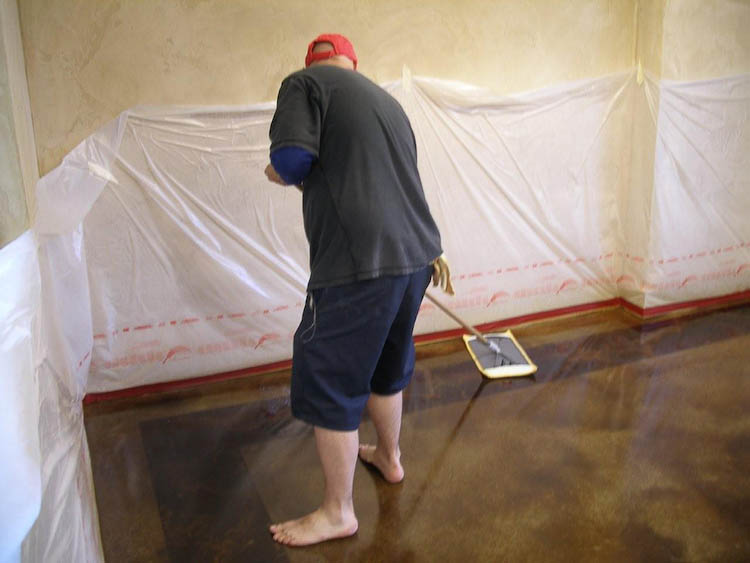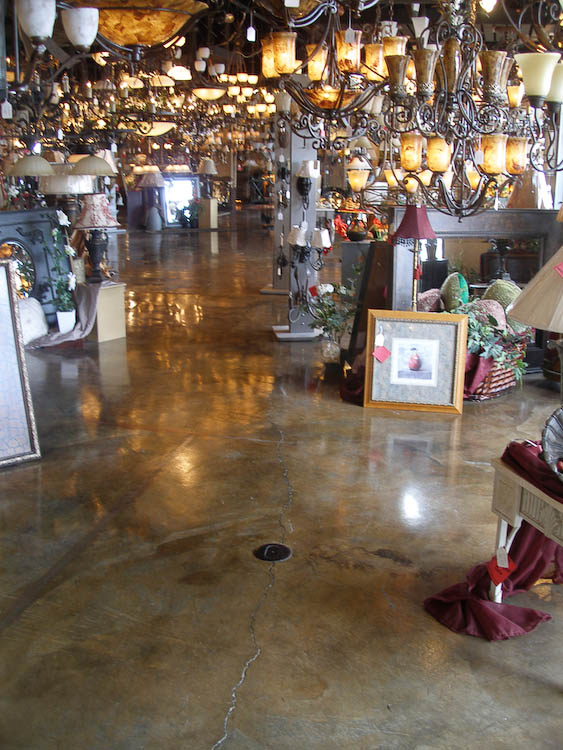Last spring we were hired by an Episcopal Cathedral in downtown Albuquerque for a job which was completely new to us. They were redesigning an outdoor area which was surrounded on three sides by the old church building. The fourth side featured a wrought iron gateway which gave onto the city sidewalk and could be locked. The centerpiece of the enclosed patio was to be a walking labyrinth.
A labyrinth is different from a maze in that there are no walls and no tricky dead ends. A labyrinth has a clear starting and ending point. One enters and walks a convoluted pathway slowly until reaching the center. In the center one can pray or meditate, then walk back out the way he came. The church planned to hire a young man named John Ritter to lay out the design and consult with the artisans. His company, called Paxworks, has created labyrinths made of brick, stone and even mowed grass, but this would be his first design done with acid stains.
The labyrinth selected was one John has designed based on a Medieval French labyrinth in Chartres Cathedral, only smaller, containing five circuits to the central rosette. Our slab was to be nineteen feet in diameter. I downloaded the design from John’s website: www.paxworks.com and had Kinko’s copy it onto a piece of clear plastic. I had to convince the church’s renovation committee that we could do the job and show them what it might look like. I made several 8×10 photographs of floors we had done in various faux textures (a marble look, a granite look, and a calligraphic look). When I placed these under the plastic with the labyrinth design over it, they could get an idea of how their patio might look.

1. Second staining
The church committee selected a medium brown marbleized look. They had a nice circular slab placed and troweled to our specifications. I also requested two small sample slabs be made from the same pour which we could use for color sampling. These turned out so nicely that they were later set into the grassy border as stepping stones to the entry of the labyrinth. The committee agreed that we should do the labyrinth outlines in a dark walnut color, rather than black, as it would be more harmonious with the background.
My assistant and I spent two days cleaning and doing the background staining. Even though it was perfectly troweled, the slab was somewhat resistant to our stain. The weather was unseasonably hot and the slab was not shaded by trees until late in the afternoon. We used thin plastic laid into the stain to create a marbleized pattern, but had to scurry fast to lay stones down on each section, since it seemed to dry instantly in the sun and wind. This lifted the plastic which we needed to keep in place to create a mark. We were disappointed with our first staining and returned early the next morning when the slab was cooler for a second staining. This time we got better pattern and felt lucky that our work area was surrounded by sunken drainage areas filled with handy river stones. (see photo 1)
The next day we scrubbed off the residue and John Ritter arrived to lay out the design. He had a small box containing a few templates and a clever sort of plate with a central spike which he taped down in the center of the circle to use as a pivot for his compass lines. The rest was done with mathematics and years of experience. I saw him do it, but I could not fathom how he laid out the concentric spirals without getting hopelessly confused. In a few hours he had the entire design drawn out for us in pencil. He wanted to see how we would mask it off, so I handed him a cup of liquid latex rubber and showed him how to brush it outside the lines with a two-inch chip brush. (See photo 2).

Laying out the design (John is on the right)
Outlining the design took all of us the rest of the day. The next morning we tested our dark walnut color and applied it. The central rosette was the most detailed area to outline and stain. (See photo 3).

3. Detail showing center rosette
A breeze came up every afternoon and caused the trees around the slab to drop small flowers across it. As they decomposed they left darker brown marks which we could not remove from the background stain. We decided that this was God’s input and we would do best to welcome it as an “added layer of complexity.”
We carefully scrubbed our walnut stain the next morning using small brushes and a sponge, before pulling up the latex rubber outlines. The latex rubber makes a crisp line and an impervious resist but it inevitably pulls up some background stain color in the smoother areas. We used a diluted brown stain to re-color those areas. The stain only needs to sit thirty minutes on retouching to even out the color. (See photo 4).

Gaye cleaning off some retouch stain.
We sealed our work with four coats of an extremely durable solvent-based acrylic sealer which Dayton Superior makes for parking garages and gas stations. It is called J-35 Tuffseal, a high-gloss, single component and UV stable product. We rolled it on using a short-napped phenolic core roller cover made for adhesives. The sun was so intense by 10:00 am, as we finished the first coat, that we got some stringing of the sealer. We knew we would have to wait until early the next morning when the slab was cool to apply subsequent coats. We got lucky while applying the last three coats of J-35. The surrounding trees had finally dropped all their flowers and the wind died down. (Photo #5 shows the finished labyrinth).

5. The Labyrinth, finished and sealed
Due to trees and the weather, this job involved more steps than I anticipated, so we did not make a profit on it. However, it is a great addition to the Faux Real portfolio. We became friends with John Ritter and expect that he may call on us to help him stain some future jobs. He said that this labyrinth was much less complicated and quicker to execute than those made of brick, mosaic, or stone. John began his career as a banker, doing his first labyrinth as a courtesy for his church. He enjoyed it so much and received so many requests for others around the country, that he quit banking to become an artist. The labyrinth field is still expanding, as more churches decide to incorporate meditation practice into their other forms of worship.
The labyrinth was really fun for us to do. It convinced me that in a “down” economy I might do well to take on more special logo or design jobs. If I bid them correctly, most could be completed in five days with one or two helpers.


































































































































































































































































